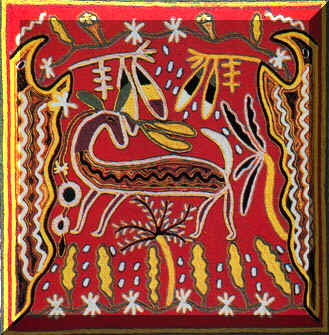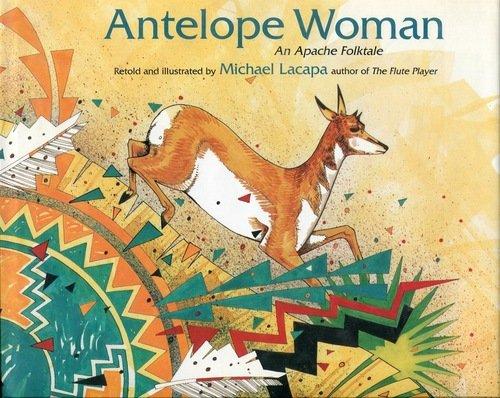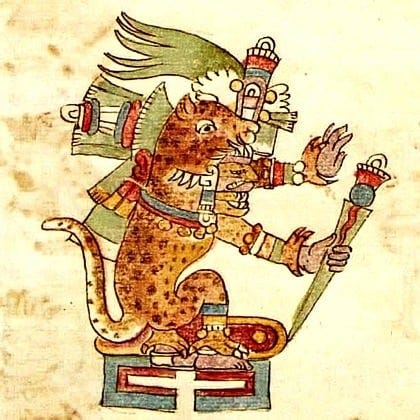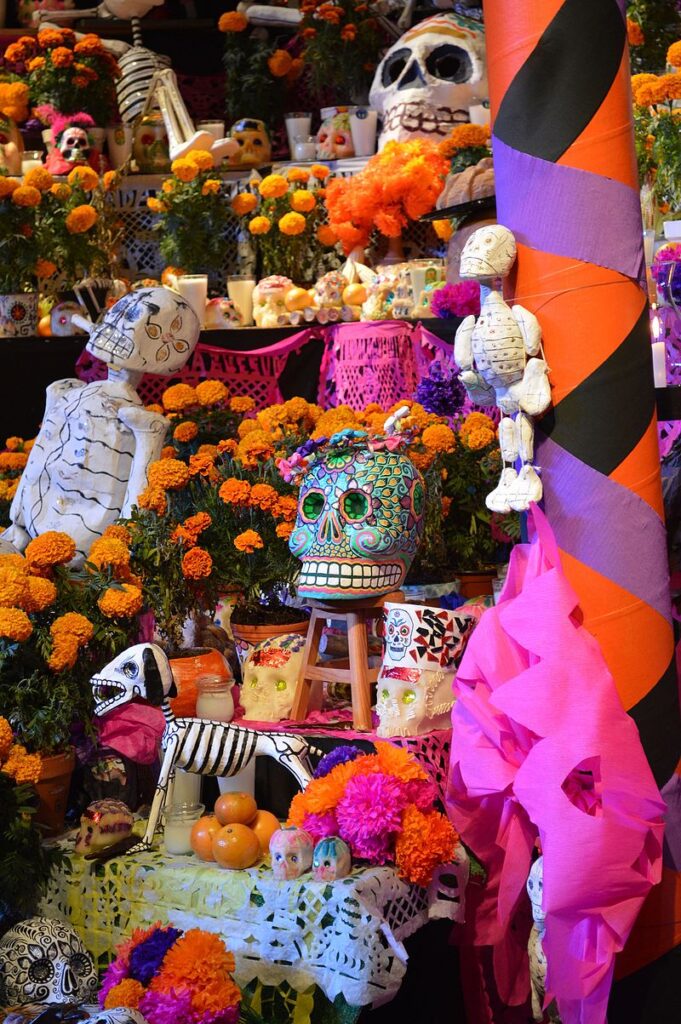
Our history is a living history, that has throbbed, withstood and survived many centuries of sacrifice. Now it comes forward again with strength. The seeds, dormant for such a long time, break out today with some uncertainty, although they germinate in a world that is at present characterized by confusion and uncertainty.
Rigoberta Menchú Tum – Nobel Peace Prize Laureate 1992
In rereading the story of “El Dorado” I have heard similar versions of them. It is normally said that there was no treasure to be found aside from trinkets, and travelers were encouraged to seek this legendary “city” to gain riches untold. That the king dipped himself in gold and descended into Lake Guatavitá, never to be seen again. In the end. El Dorado remained a myth perpetuated by the Spanish to send upstart explorers on a fool’s quest or suicide mission. Had I heard the story as a young man in the ancient past, I would seek it.
Fear Not the Dark, My Child: The Hidden Spirits of the Cheyenne
The Spanish Conquest throughout South America and European colonization of the North America led ancient indigenous thought, theory and culture by the wayside, forever lost to contemporaries and the modern people outside of wall paintings and hieroglyphs. Would we have benefited from their knowledge to sustain our world? Pop culture teaches us that the burning of libraries and suppression of cultures have destroyed our potential and doom us to repeat mistakes of the past. Indigenous American perspectives are generally told through secondary accounts of colonizers unfamiliar with and xenophobic toward the cultures. In art and architecture as well as poetry and wider verse, one deduces what a Western mind calls a natural sensibility. One could use the Cheyenne – an ancient but extant group of indigenous peoples in the Great Plains. – and their story of the origin of the sun and the Aztec sun stone to cross-examine the relationship between humans and nature, directly axiomatic to Native American worldviews of the all-maker and one’s spiritual connection to the earth.
One Cheyenne story, the origin of the sun, details the world shrouded in shadows and darkness. In that darkness, animals are born and must navigate this dangerous crux of the abyss. They counsel and reason how to introduce light into the world, realizing that if shadow exists, there must also be a non-shadow, or ligth existing in a far-off land which they could steal for themselves. Ancient, but applicable to the modern age. To find this light, every animal is sent single file into the night. A possum procures the light and is scorched, left hairless and unable to see. The vulture attempts the same theft using his feathers, and is left bald. Moving, let alone harnessing the power of the sun is beyond their capability. Yet it is Grandmother Spider who has devised a bowl and spun her web to guide her home.
Stories in Native American folklore were documented findings as early as the 17th century, with physical records of existence in caves and stone monuments existing centuries before. These stories are often told orally, building a human connection as the story is emotionally portrayed by a wizened member of the community, one generation to the next. Animals are oft, perhaps naturally, part of these stories among the Cheyenne (Humanistic 458) and play the important role of knowledge transference among humanity, who are relatively new on the planet as a sapient species. In traditional native stories, humanity is a vessel, traversing the hellish landscapes to acquire wisdom to later establish a sense of “self” and a line of reasoning. This may lead to the worship of idols, nature and forces that have demonstrably greater power than any man.

This differs from Western storytelling which focuses on ancestors, great heroes and slayers, and saints that lead the spiritual world. There is always a body” in Western stories and avoid the metaphysical discussion of what lies beyond the human form. When there is a theological story, these beings exceed nature – think angels, demons, gods, spiritual robots etc. Native American thought processes however, give appreciation to an animal ensemble that are “easily” transferred to a new generation, where a central theme is that all animals are sacred, and must still offer sustenance to the land and humankind. The storyteller, ravaged by a youth of war and famine, are not only conversant with descriptively majestic beasts, but are in tune with nature itself. Both ancient and modern times feature nature as that which Native Americans attribute to explaining the unknown, much how one uses science and religious forces as determiners for how the world works. Grappling with the unknown and creating a concept to explain it is one of humanity’s oldest traditions.
In another Native American culture far diverged from the Cheyenne, the Aztecs and Nahuatl/Uto-speaking people also share an affinity for nature. Defending their beliefs to Spanish friars in the 16th century, a “Tlamatini“, a “wise one” or Aztec lord, described the role of natural philosophers as “instructing how our gods must be worshiped, whose servants we are, like the tail and the wing” (León-Portilla,19). This aligns with Aztec iconography’s insistence to use animals as both metaphors and explanations for natural phenomena beyond earth, representing symbols for deities and the stars in space.
Lead the Way, my Sun
As animals and spirituality are native to the natives, this story would not be complete without discussing the avatars of nature and the human spirit. Consider a modern Mexican story of the Mesoamerican nahual, animals were companion spirits as well. For Mayans and Aztecs, naguales are a secretive and spiritual society that touted base neutralist magics, totemism, and beast-guardians which were suppressed heavily by pro-Catholic teachings following the Spanish Conquest. If the beast died, so too would the Naguale people.
Often, the Nagual would enter a forest, cave, hill or hidden place, and call upon spirits with certain names, begging the rocks, woods and waters for fortune and plentiful crops. Animals were sacrificed, blood used to make contracts, and mystic phenomena allegedly would occur to allow a Nagual to inherit a spirit of their own.
To excerpt Carlos Baresh’s Hummingbird Hill Ranch:
Long time ago, there lived gods here. There lived simple people, and there lived gods… but they [the people] wanted guardian that was strong and smart. That had the power they didn’t have… The word is “nahualli”, a being of double projection… Nahuales are spiritual animal forms. They are our guardians. They are not bad and are not good.
Señor Pozos, Hummingbird Hill Ranch, 28

In Baresh’s tale, we are given specific criteria to the appearance of an animal spirit:
- Nahuales are neither positive or negative spirits; their morality is inherited from their partners’ alignment.
- Nahuales can stay with one all their life, a second or more nahuale can be found, or one might never discover their nahual.
- Gods could have a nahuale spirit of their own as an avatar.
- Nahuale can be anything, but are typically the animal representing the day you are born on. The Sacred Calendar determines your Aztec sign.
- Your nahual must choose you, and you must choose it. Any rejection = no companion spirit.
- They are thought to gravitate towards people of great importance.
Animals being indicative of metaphors, idioms and aphorism lend instruction to the people: where an axolotl is considered a sacred water god that is also included in Mayan and Aztec diets, so too are the sun and its requisite sacrifices on which Aztec worldviews are built. For Aztec history, the four divine sons of the god Ometeotl: Quetzalcoatl, Huitzilopochtli, and the combined Tezcatlipocas, do battle to claim supremacy, which is symbolic of four classical elements of Aztec culture (León-Portilla, 46). Where one son is dominant in battle, his victory is signified by the vivid shine of the sun. Per Alfonso Caso, their struggle is for the history of the world, their triumphs determining the state of other creations. (ibid) The Aztecs of Tenochtitlan then embarked on an ambitious project with this knowledge in tow: preventing the death of their sun by all means by feeding it via human sacrifice.
Ritual sacrifice, admonished today due law, morality, ethics and science, was a celebrated and common act for ancient cultures. The natives then had a purpose and identity. To paraphrase:
The indigenous groups of Mesoamerica became a chosen people who believed their mission was to side with the sun in their cosmic struggle and to side with goodness to ascertain its triumph over evil. To give humanity the benefits of the victory of the light over the powers of the night. The Aztec, like anyone who believes himself to have a mission, were eager to carry it out if his conquest of other peoples was brought about.
The Aztec and Mayan as a collaborator of the gods, carrying out a transcendent duty and that his action lay the only possibility for the world to continue existing, made endurable all the suffering of long pilgrimage. In addition, this idea allowed them to establish themselves in a place where richer and greater cultured peoples would had declined, motivating them to impose themselves upon the surrounding people via subjugation and expand the power of Tenochtitlan until they reached from the Gulf to the Pacific.
León-Portilla, Aztec Thought and Culture, 37
When observed this way; despite the nobility of interpreting the sun, animals and nature as sacred and respected forces, using protection of a god’s domain and human sacrifice as impetus for conquest of weaker tribes is not all different from the Spanish Conquest of the Aztecs themselves. While this is not an observation of right and wrong, the overlap of outcome despite the sharp differing in faith, reason and culture from the Spanish is an interesting note. As cultural and technology developed to better accommodate the gods’ worship, Nahual spirits evolved to represent more characteristics and traits. They are not exclusive to the Aztecs; the Zapotecs, Mayans, Toltecs and Olmecs also recognized animal spirits as native to human spiritual development.
The Who? Nagual as a Catch-all Term
Brinton’s exhaustive list below describes the many phrases related and derived from the phrase “nagual” to differentiate use, as one word is dependent on context of the sentence:
From the Maya, of Yucatan.
- Naual, or nautal, a native dance, forbidden by the missionaries.
- Naatil, talent, skill, ability.
- Naat, intelligence, wisdom.
- Naatah, to understand, to divine.
- Nanaol, to consider, to contemplate, to meditate, to commune with oneself, to enter into oneself.
- Noh, great, skillful; as noh ahceh, a skillful hunter.
From Maya Dialects.
Quiche-Cakchiquel.
- Naual, a witch or sorcerer.
- Naualin, to tell fortunes, to predict the future.
- Qui naualin, to sacrifice, to offer sacrifices.
- Na, to feel, to suspect, to divine, to think in one’s heart.
- Nao, to know, to be alert or expert in something.
- Naol, a skillful person, a rhetorician.
- Naotizan, to make another intelligent or astute.
- Natal, the memory.
- Natub, the soul or shadow of a man.
- Noh, the god of reason (“Genius der Vernunft,” Scherzer).
- Noh, to fecundate, to impregnate (Popol Vuh).
Tzental.
- X-qna, to know.
- X-qnaulai, to know often or thoroughly (frequentative).
- Naom, wise, astute (naom vinic, hombre sabio).
- Naoghi, art, science.
- Naoghibal, memory.
- Ghnaoghel, a wise man.
- Alaghom naom, the Goddess of Wisdom.
From the Zapotec, of Oaxaca.
- Nana, gana, gona, to know.
- Nona, to know thoroughly, to retain in the memory.
- Nana ticha, or nona lii, a wise man.
- Guela nana, or guela nona, wisdom, knowledge.
- Hue gona, or ro gona, a teacher, a master.
- Na lii, truth; ni na lii, that which is true.
- Naciña, or naciina, skill, dexterity.
- Hui naa, a medicine man, a “nagualist.”
- Nahaa, to speak pleasantly or agreeably.
- Nayaa, or nayapi, to speak easily or fluently.
- Rigoo gona, to sacrifice, to offer sacrifice.
- Ni nana, the understanding, the intelligence, generally.
- Nayanii, the superior reason of man.
- Nayaa/Naguii,} superiority, a superior man (gentileza, gentil hombre).
From the Nahuatl, of Mexico.
- Naua, to dance, holding each other by the hands.
- Naualli, a sorcerer, magician, enchanter.
- Nauallotl, magic, enchantment, witchcraft.
- Nauatl, or nahuatl, skillful, astute, smart; hence, superior; applied to language, clear, well-sounding, whence (perhaps) the name of the tongue.
- Nauati, to speak clearly and distinctly.
- Nauatlato, an interpreter.
Beast-folk and The Dark Arts: 19th Century Depictions of Nagualism
Surgeon and historian Dr. Daniel Brinton counterargues in his 1894 text that nagualism is akin to cultism with power equal to many tribes in ancient Mexico and Central America, which contrasted government and practiced religion. Nagualism is not an officially recognized religion, however they are noted to be equal in knowledge distillation and repository collection to thaumaturgists and theodidacts. They were arguably also feared among the Spanish Conquistadors as magicians who could make a stick into a serpent, and know all forms of sorcery for evil intent (Sahagun 9).
Among Mayan tribes of Yucatan and Guatemala, Father Bartolomé de Baeza notes during his expedition in Yaxcaba in the early 1800s, that an old and dying man declared that he could transform into an animal, undoubtedly his spirit animal chosen in youth, whereas a twelve-year old girl would instead say she was forced via witch magic to shift into a bird. Baeze describes this as a lucid dream, but a common dream among the Mayan superstition. (Registro 165).
Later, in 1854, nagual written formulas for collected by historian Torquemada and Jacinto de la Serma and identified as formulae for reversing Catholic baptisms. Through pagan ritual, children who were formally baptized were taken to forests and caves for secretive rituals involving tobacco and hallucinogenic products left to ferment.
The nagual are also fascinatingly described as masters of weather manipulation, who conjure clouds during hail and torrential rain to protect the crops. Said depiction directly counters the appreciation of earth; would the “masters of nature” not know solar eclipse enough to control them to strategic advantage during Cortes’ invasion of Tenochtitlan? NASA estimates there were approximately 228 solar eclipses between 1500 and 1599, 28 of which took place during the Spanish Conquest of the Aztecs between 1519 to 1530, 7 of which were visible in the region. A hastily put together Aztecan army would have benefited from controlling the light and shadow array during day and night.
Mexican writer Andres Iglesias, in the 1870s, visited the village of Soteapan, in the State of Vera Cruz to verify the Mixe language’s relation to Nahuatl and the overlap between customs of the chosen nahual spirit. With the high priest known as “The Thunderbolt”, claiming to control the seasons to mitigate or create torrential hurricanes, said knowledge clashes with earliest 17th century Spanish encounters with the Tlamatini, who are described as warfaring, but noble and almost certainly not magicians. Between the Oaxacans, who used their calendar specifically for astrological purposes to determine the nahual spirit, and the Zapotecs, who determined the spirit by date of birth, there are overlapping beliefs even between warring states during the 16th century.
Sangre en la Blanca Rosa: The “Dangerous Woman” in Nagualism
Brinton later described two uprisings related to the nagual, who up to this point were depicted as a wise spiritual, splintered group: in 1713 and 1869 which is a recent event to Brinton’s own publication. The uprising, led by twenty year old Maria Candelaria – an indigenous woman shunned for being the child of a prostitute – rose against the Spanish presence by leading a Nagualist religious sect numbering seventy thousand to fight for the freedom of Chiapas:
Her authority was absolute, and she was merciless in requiring obedience to it. The disobedient were flayed alive or roasted over a slow fire. She and all her followers took particular pleasure in manifesting their hatred and contempt for the religion of their oppressors. They defiled the sacred vessels of the churches, imitated with buffoonery the ceremonies of the mass, which she herself performed, and stoned to death the priests whom they caught.
Brinton, Nagualism: A Study in Native American Folk-lore and History
Spanish Basque conquistador Pascual de Andagoya noted that women were not only exalted among Nagualist groups, but often held the highest positions. His specific phrase to determine the woman as both a primate and hierophant plays as an onomatopoeia, that their power enabled them to be in two places at once. Physically and metaphorically, the Spanish interpreted the indigenous as a threat, backed by protections from their native gods. Additionally, their depictions as shapeshifters is derived from an urban legend that an enchantress had taught the Nagual people to become their “tonal” guardian spirit at any time, leading to suspicions from colonizers and other tribes.
While Candelaria’s coup failed, as a woman, the Spanish were given a sharp reminder that rebellion and a fight to restore a way of life can take place anytime, from anyone.
Is Nagualism Celebrated Today?
That question is not often asked; there is an understanding that modern Latin American cultures who can trace their roots to Mesoamerican and northern Indigenous cultures of Native Americans often appreciate and respect the spiritual bond between man and earth. This is best presented in yearly ofrendas and rituals to show familiarity with antiquated musics, paintings and other artistic forms.
In literature, the nagual is echoed in texts from Harry Potter via the Patronus and Animorphs, which feature humans shapeshifting into animals to combat personal, societal and dangerous elements of the world. Navajo ancestry can also trace the connection to animals and nature to the ancient past, with the ability to contact the spiritual in ways the modern human cannot. The soul, said to have an infinite number of lives, would encounter and properly bond with a spirit.

Magic is felt everywhere you go, and in every one who has a story. At the very least, many modern Mexicans and Guatemalans have heard a folk story dating far back, amalgamated with seeming superstition that rooted from a culture of compassion. Even through the Spanish conquest and subsequent imposition of Catholicism that is practiced by modern Mexican cultures today, ancient tradition stands strong. Dia de Los Muertos is a fine example if one who connects not only spiritually, but emotionally as they reflect the power and memory of the departed.
A Nagual then, much like human departed souls, provide awe-inspiring magic, advise and protect their charge when we are in danger, and can kill to defend. There are even animal spirits said to defend entire cities in Mexico today, representing the raw animal nature of each person. This leads to the impression of magicians present among the Spanish friars of the 16th century.
It is a beautiful and traditional legend full of color, music and life that passes the hands of many generations, each form different than the last. While I cannot trace my own roots to it, Nagualism as a new concept is mystical and magical; an excellent story to share.
To the New Year!
Sincerely,
N
Works Cited:
- Baresh, Carlos Leonardo. Hummingbird Hill Ranch: Humorous Stories from the Subtropical Mountains of Mexico. Createspace. 2015.
- Brinton, Daniel G. “Nagualism. A Study in Native American Folk-Lore and History.” Proceedings of the American Philosophical Society, vol. 33, no. 144, 1894, pp. 11–73. JSTOR.
- Fiero, Gloria K. The Humanistic Tradition: Prehistory to the Early Modern World. 7th ed., vol. 1, McGraw-Hill Education, 2015.
- León-Portilla, Miguel. Aztec Thought and Culture: A Study of the Ancient Nahuatl Mind. Translated by Jack Emory Davis, revised ed., University of Oklahoma Press, 1990.
- Bernardino de Sahagun, Historia de la Nueva España, Lib. x, cap. 9.
- Registro Yucateco, Vol. i, p. 165, seq.
- Torquemada, Monarquia Indiana, Lib. ii, cap. 62.